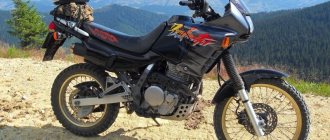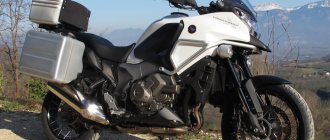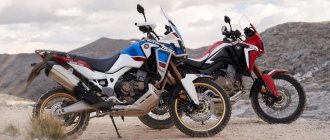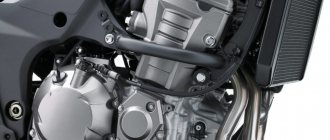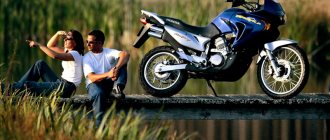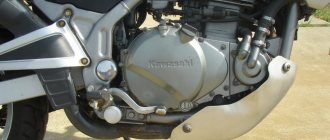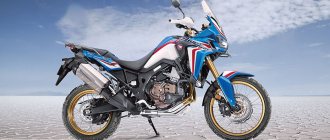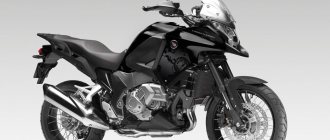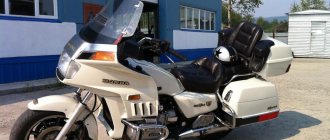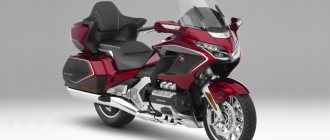Two Africa: Honda Africa Twin 1991 comparison with 2019
Yes, the new Africa is not the same. Literally not the same: it really is a different motorcycle. The original version is 30 years old, but put it next to the 2022 model and the question is which looks better. The old lady has no ABS, no traction control, no riding modes, and the misunderstanding called "carburetors" will remind you how far motorcycles have come in the last couple of decades.
For every supporter of traveling on reliable and indestructible old motorcycles, there is a supporter of newer, unworn ones. And for everyone whose old car broke down on the road, there is another one who curses the new motorcycles that are made from Chinese rice plasticine. There are reasonable arguments in favor of both old motorcycles and new ones, but the main and most correct argument is this: choosing a motorcycle is a personal matter for everyone, and there is no single proven option.
Bike features
The motorcycle has the following advantages:
- surprisingly high cross-country ability;
- really powerful engine;
- ease of landing.
However, it would take a very long time to list the advantages of this model. It is not only beautiful in appearance and characteristics, but also very reliable. The motorcycle will hardly need any repairs. It is hardly possible to imagine something more suitable for long trips.
Honda Africa Twin 1991 and 2022 off-road comparison
In the meantime, we started off-roading. At the first stage we found a ravine with a river below, the slopes of which formed something like steps made of stone. I felt completely confident on the Honda Africa Twin 1991 RD04, holding the line without any problems, getting out of drifts easily and using the grip and bottom-end traction to lift the front wheel off the rocks. From the outside, if you close your ears, the old motorcycle looks in its element. But if you don’t close it, you’ll hear the crankcase protection hitting every big rock. And at the end of the journey there is a roar of relief when the rider can finally release the tight clutch.
Honda Africa Twin 1991
The new Africa seems tall and heavy, but surprises with its excellent ground clearance and excellent suspension. And the transmission with DCT is striking in its intelligibility: the motorcycle clearly and predictably responds to gas, although we predicted problems with the automatic transmission on the off-road.
As we moved onto flatter terrain, 30 years of technology development disappeared into dust. The quality of the Adventure Sports suspension is excellent. It's not overly dynamic, leaning more towards stability than playfulness, but it soaked up all the bumps we tested it on, feeling like a magic carpet hovering over rocks and ravines. In contrast, the fork of the old motorcycle had difficulty coping with the terrain, causing it to shrink on loose rocks, and rapid entries into holes caused powerful breakdowns. On smoother terrain the Africa Twin 1991 RD04 rides really nicely and allows you to push your skills a little further. The new motorcycle, due to its high weight and high center of gravity, feels like a walking tank from science fiction: it seems that nothing can shake it, but that is until it loses its balance. Then - hold on!
The DCT transmission is a work of mechanical art by Honda's great craftsmen. Whether your new motorcycle will have such an automatic transmission or not is a second question, but one cannot help but admit that it works perfectly here. We were constantly trying to get Africa Twin to do something that would make them go “Aha! Damn machine gun!” - and nothing worked out for us. Time after time, the damn automatic machine amazed me with its dexterity and ability to choose the right gear, even on a slippery dusty slope. If you have perfect clutch control off-road and never make a mistake with a gear, even during a race, then DCT won't do much for you. But for everyone else, the electronically controlled transmission is a boon, allowing you to launch smoothly without setting the rear tire on fire or trying to tumble over your back. Plus, when you shift down with the throttle button, it makes a cool, satisfying click.
The Africa Twin in particular, and touring enduros in general, have come a long way over the last three decades. What the new product definitely won’t be able to surpass the old lady is the smell.
Old Africa in the parking lot smells of oil and gasoline, evoking memories of the distant 90s, superbike races and the thick smell of unburnt hydrocarbons. It's probably not great for the environment, but it's damn soulful.
Engine
The bike is equipped with a wonderful V-shaped engine. This four-stroke and two-cylinder unit has a displacement of 742 cm³. The engine is cooled by liquid; there are three valves per cylinder. The fuel supply system is carburetor.
Peak engine performance: at 6500 rpm the torque is 62 Nm, and at 7500 rpm the power is 60 hp. The peak speed of the XRV 750 is 170 km/h, and the car will accelerate to 100 km/h in 4.6 seconds. These characteristics alone do not provide an understanding of why the model is so good.
Comparing two Africas
Comparing the two Africas side by side, you realize that these models are definitely similar. Honda has released a lot of gray and faceless models since 1991, but the charisma inherent in the Africa Twin of those years can be seen in the new version. From the similar color schemes to the shape of the tank and seat, much of it is a reference to its glorious ancestor. Which, against the backdrop of the descendant, for some reason brings to mind thoughts of minibikes.
Honda Africa Twin 1991 and 2019
Africa Twin 1991
When the Africa Twin came out in the '90s , asphalt riders grumbled about the high seat and off-road riders complained about the hefty weight. By today's touring enduro standards, the then Africa was compact, nimble and light. The new one, in comparison, is strangely tall, with a high center of gravity and not very comfortable in tight spaces. And even after hundreds of kilometers, every time one of us folded the side stand on it, the rest looked at it with some apprehension: it will hold it, no? But two of the testers finished in Dakar and had decades of experience riding touring bikes. At the same time, Old Africa evokes only one thought: about all-climbability and invulnerability, multiplied by a lighter weight, so in especially scary places it always found itself in front with open gas.
In the very first minute of the first round, the old woman won over. I turned on the ignition of the '91 Africa, pressed the starter button, and after remembering what a choke was and how to use it, the bike started with a pleasant grunt from the typical Arrow muffler of that era. And my partner, laughing at my fuss with the choke, jumps on the second motorcycle, starts, moves off and immediately stops to try to change the riding mode.
Africa Twin 2019
When you saddle the new Honda Africa Twin , then at every stop, gas station, every damn traffic light, your eyes are riveted on this huge device, and you are looking for how to turn on a sharper throttle response, manual transmission mode, gravel driving mode or ABS off button. No, it’s all cool that the motorcycle has so many options, but it takes a lot of time and clutters your head. And at the same time I’m already piling along the side of the road, entertaining myself with power slides in the dust. Yes, when we figured out the settings, they stopped taking a lot of time, but still, every time you start you have to do a couple of important things in the menu - for example, turn off ABS and enable manual transmission shifting. On the road this is not a very important issue, but off-road, where we stopped more often to check the maps, it began to irritate. Stop. Handbrake. He pulled out the stand. I turned off the ignition. I turned on the ignition. I removed the stand. I took it off the handbrake. Menu - Transmission - Manual. Menu - ABS - rear off. I opened the gas and started moving.
True, the time spent on the Africa Twin menu is quickly made up for on the road: long gears and more power give it an advantage over the 62-horsepower 750. And with the transmission set to fully automatic mode, driving turns into an easy, relaxing winding of kilometers on the wheels. The Adventure Sports model has a high seat and a high windshield, which make for a damn nice riding position: you sit high, can see far ahead, and are perfectly protected from the wind. The automatic transmission shifts smoothly, allowing you to simply open and close the throttle without having to think about what gear you're in. But when you change gears on an old motorcycle and squeeze the tight clutch, somehow you fall less under its charisma.
Honda Africa Twin 2019
Dimensions and weight
The curb weight of Honda's XRV 750 is 234 kg, while its dry weight is 207 kg. This weight cannot be called too much for a touring motorcycle of the level of this model. The fuel tank capacity here is 23 liters, which is very good for such a bike. Actual gasoline consumption is about 6-7 liters for every 100 km of road. The length of the motorcycle is significant - 2320 mm. The width of the XRV 750 is 905 mm, and the height is 1430 mm. The wheelbase is impressive – as much as 1555 mm. The height of the model at the saddle is 870 mm.
2022 Honda Africa Twin
As for the 2022 Africa Twin, it is very far from the first version in terms of equipment and specifications. Against the backdrop of carburetors, flexible turn signals and the twitchy speedometer needle of the RD04, the new motorcycle seems like a spaceship. The second model to represent the 2022 Africa Twin in our test is called the Africa Twin Adventure Sports, and it can be equipped with a dual-clutch automatic transmission (DCT). Compared to the standard 2022 Africa Twin, the Adventure Sports has longer travel suspension, larger tank capacity, a larger instrument panel and an additional ride mode - Gravel. The DCT version has two clutches with an electronic drive - this is a complex automatic system that makes traction control simple and understandable: turn off the gas - go, turn it harder - go faster. But for those who like to click something, this version has buttons for manual transmission control on the left remote control. The characteristics of the 2022 Africa Twin, of course, also eclipse the old Africa of 1991: 93 horses, however, the weight has also increased and is 242 kg.
Chassis and brakes
The frame is made of steel. Its contours impress with elegance and strength. There is something in the appearance of a motorcycle that declares its undeniable power and reliability. The colors are perfectly chosen. The wheels are spoked. The steering wheel is a convenient and reliable control tool.
The rear suspension has a travel of 214 mm; it is a pendulum version with a monoshock absorber. The front suspension is a telescopic fork with a size of 43 mm and a stroke of 220 mm. The rear brake is a 256 mm disc with a single-piston caliper. At the front there are two discs, each measuring 276 mm, and the caliper is two-piston.
